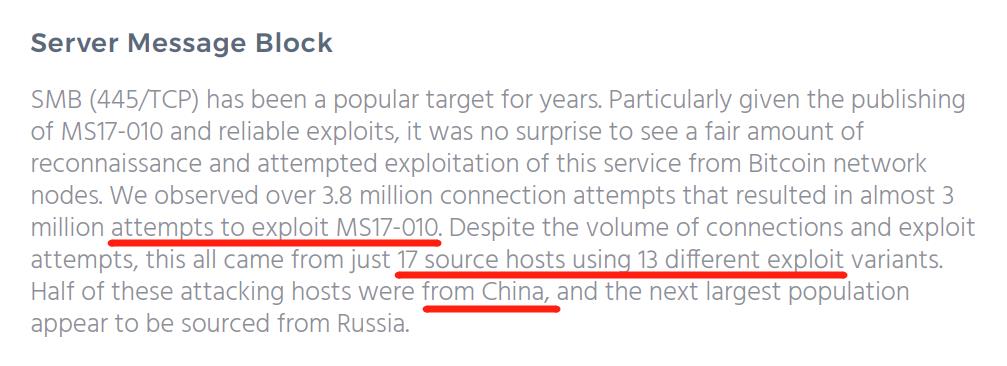OFF THE CHAIN: Observing Bitcoin Nodes on the Public Internet
Contents
Reference
比特币网络比互联网邪恶3到10倍 – 《链下:公共互联网上的比特币节点》
http://www.aqniu.com/industry/33948.html
OFF THE CHAIN: Observing Bitcoin Nodes on the Public Internet
https://www.rapid7.com/globalassets/_pdfs/research/rapid7-block-chain-research-report.pdf
比特币节点识别的原理及实现方式 绿盟科技研究通讯 2018/09/07
内容编辑:物联网安全实验室 魏佩儒 张星 责任编辑:肖晴
wechat_link
https://bitcoin.org/en/full-node
https://github.com/ayeowch/bitnodes
Project
Rapid7’s Project Heisenberg
https://blog.rapid7.com/tag/project-heisenberg/
Rapid7’s Project Sonar
https://opendata.rapid7.com/about/
Rapid7’s Project Heisenberg tracks connections to and the probing and attempted exploitation of various services on a large set of globally
distributed honeypots.
Rapid7’s Project Sonar is a security research project running since 2013; it uses internet scanning and collection to gain insight into exposure of common services and vulnerabilities, and it provides tools and data to enable and advance security research.
Project Sonar scans the public IPv4 internet on a weekly basis looking for nodes with port 8333/TCP open (Figure 2).
Bitnodes
https://github.com/ayeowch/bitnodes
其他有趣的发现

Detect Nodes in Bitcoin Network (原理)
Project Sonar scans the public IPv4 internet on a weekly basis looking for nodes with port 8333/TCP open (Figure 2). Nodes with this port open are then connected to, and the information exchanged during handshaking—including version information and basic capabilities—is stored for later analysis. Project Sonar observed between 10,000 and 12,000 unique IPv4 addresses exposing the Bitcoin service on 8333/TCP during any given week. In the frst quarter of 2018, just over 28,000 unique IPv4 addresses were observed.
Bitnodes, in contrast, uses a different method to get insight into the Bitcoin network. Bitnodes uses a set of seed peers to connect to the Bitcoin network and then issues the getaddr command to fnd that node’s list of known, active nodes, repeating this process recursively to discover all nodes in the Bitcoin network at any one time. Like Sonar, Bitnodes records the version information and basic capabilities. Bitnodes takes this assessment further by gaining visibility into Bitcoin peers not operating on the standard 8333/TCP port. Ninety-seven percent of the nodes in Bitnodes operate on 8333/TCP, but there are nearly 600 additional ports in use; these are likely common alternative ports such as 8555, 8334, 8338, 8433, 8833, and more. Additionally, Bitnodes records how long any given peer has been participating in the Bitcoin network.
搭建 Bitnodes
Provisioning Bitcoin Network Crawler
https://github.com/ayeowch/bitnodes/wiki/Provisioning-Bitcoin-Network-Crawler
Bitnodes API
https://bitnodes.earn.com/api/
ETH
ethernodes
https://www.ethernodes.org/network/1
https://github.com/ethereum/ethereumj
Java implementation of the Ethereum yellowpaper
Leave a Reply